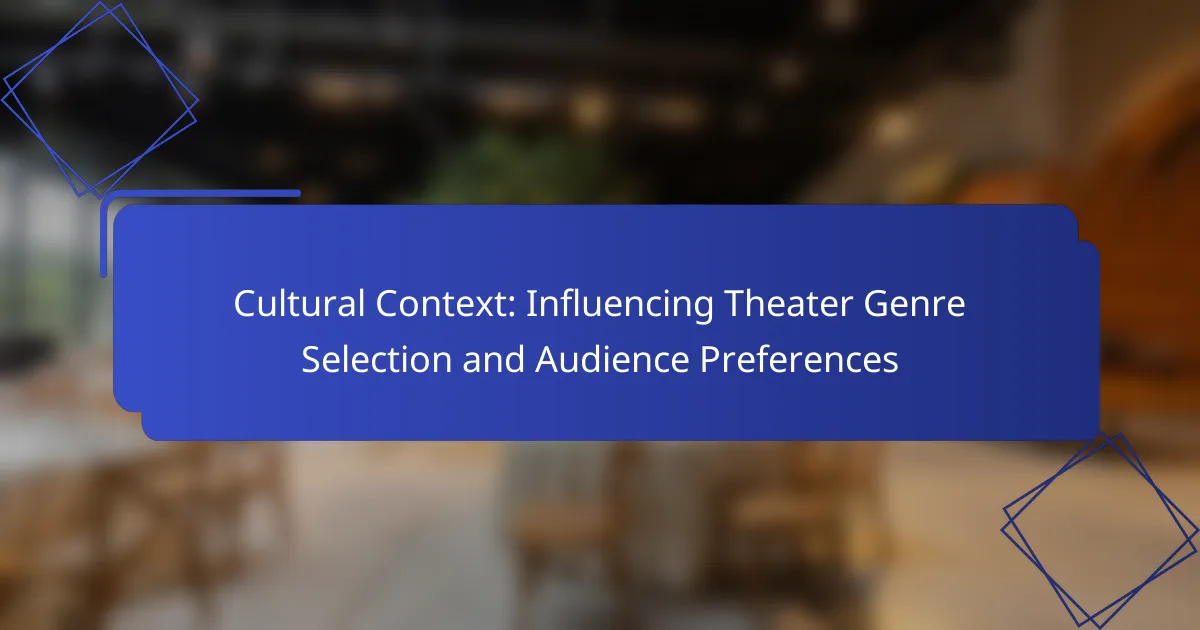When it comes to family entertainment, musical theater and straight plays offer distinct experiences that cater to different preferences. Musical theater captivates audiences with its vibrant songs and energetic performances, making it a popular choice for families seeking lively engagement. In contrast, straight plays often delve into deeper narratives and character exploration, appealing to those who appreciate thoughtful storytelling. Ultimately, the choice between these two forms of theater hinges on what families value most in their theatrical outings.

Which form of theater is more engaging for families?
Musical theater tends to be more engaging for families due to its lively performances and interactive elements, while straight plays often focus on deeper narratives. The choice between the two depends on the family’s preferences for entertainment and storytelling.
Musical theater offers interactive experiences
Musical theater captivates audiences with its combination of music, dance, and vibrant visuals, making it particularly appealing to families. The energetic performances often encourage audience participation, whether through sing-alongs or clapping along to the beat.
Many musicals are designed to be family-friendly, featuring relatable themes and humor that resonate with both children and adults. Productions like “The Lion King” or “Annie” showcase colorful costumes and engaging storylines that keep younger audiences entertained.
Straight plays provide deep storytelling
Straight plays excel in delivering profound narratives and character development, making them suitable for families interested in thought-provoking themes. These performances often explore complex emotions and relationships, encouraging discussions among family members after the show.
While they may lack the musical elements of their counterparts, straight plays can still be engaging through strong acting and compelling scripts. Productions like “To Kill a Mockingbird” or “A Raisin in the Sun” offer rich stories that can spark meaningful conversations within families.

What are the key differences in family appeal?
Musical theater and straight plays differ significantly in their family appeal, primarily due to their formats and storytelling techniques. Musical theater often captivates audiences with vibrant songs and choreography, while straight plays tend to engage through deeper character exploration and dialogue.
Musical theater emphasizes entertainment value
Musical theater is designed to entertain a wide audience, making it particularly appealing for families. The combination of catchy songs, lively dance numbers, and colorful costumes creates an engaging experience that can hold the attention of both children and adults alike.
Shows like “The Lion King” or “Wicked” exemplify this entertainment focus, featuring memorable music and visual spectacles. These elements often lead to a more enjoyable outing for families, as they can share the excitement and energy of the performance together.
Straight plays focus on character development
Straight plays prioritize character development and narrative depth, which can resonate with family members looking for meaningful stories. These productions often explore complex themes and emotions, allowing for rich discussions among family members after the performance.
For instance, plays like “Death of a Salesman” or “A Raisin in the Sun” delve into human experiences and relationships, providing a different kind of engagement. Families may find value in the lessons and reflections these stories offer, fostering a deeper connection to the material.

How do ticket prices compare in major cities?
In major cities, ticket prices for musical theater and straight plays can vary significantly. Generally, musical theater tickets tend to be more expensive than those for straight plays, reflecting the larger production costs and star power often involved.
Musical theater tickets are often higher
Musical theater tickets typically range from the low tens to several hundred dollars, depending on the venue and the popularity of the show. For instance, Broadway musicals in New York City often command prices starting around $100, with premium seats reaching upwards of $300 or more.
The higher costs are attributed to elaborate staging, live orchestras, and well-known performers. Families planning to attend should budget accordingly, considering matinee performances may offer slightly lower prices.
Straight plays offer more affordable options
Straight plays generally present more budget-friendly ticket prices, often starting from around $30 to $80 in major cities. This affordability makes them an attractive option for families or those looking to enjoy theater without breaking the bank.
While some high-profile straight plays may still reach higher price points, many local theaters offer discounted tickets or special family rates. It’s advisable to check for promotional deals or group discounts when planning a visit.

What age groups are attracted to each genre?
Musical theater generally attracts younger audiences, while straight plays tend to resonate more with older children and adults. This distinction is influenced by the content, presentation style, and emotional engagement each genre offers.
Musical theater appeals to younger audiences
Musical theater often features vibrant colors, catchy songs, and dynamic choreography, making it particularly engaging for children and teenagers. Shows like “The Lion King” and “Wicked” are designed to captivate younger viewers with their imaginative storytelling and lively performances.
Parents often find that musicals can be a great introduction to the theater for their kids, as the music and visuals hold their attention. This genre typically encourages family outings, with ticket prices ranging from affordable to premium, depending on the venue and production quality.
Straight plays resonate with older children and adults
Straight plays, which focus on dialogue and character development, tend to appeal more to older children, teenagers, and adults. Works like “Death of a Salesman” or “A Raisin in the Sun” delve into complex themes and emotional narratives that resonate with mature audiences.
These performances often require a deeper level of engagement and understanding, making them suitable for those who appreciate nuanced storytelling. While ticket prices can vary widely, straight plays are frequently seen in regional theaters, offering a more intimate experience that can enhance audience connection.

How do production styles differ between musicals and plays?
Production styles in musicals and straight plays vary significantly in their use of visual elements and performance techniques. Musicals typically emphasize vibrant sets and dynamic choreography, while straight plays often adopt a more subdued and minimalist approach to staging.
Musicals feature elaborate sets and choreography
Musicals are known for their intricate sets and lively choreography that enhance the storytelling experience. These productions often include colorful backdrops, detailed props, and complex dance routines that engage the audience visually and emotionally.
The use of music and song in musicals adds another layer of engagement, allowing for emotional expression that complements the narrative. For example, a musical like “Hamilton” combines historical themes with modern music and choreography, making it appealing to a wide range of audiences.
Straight plays focus on minimalist staging
Straight plays typically emphasize dialogue and character development over elaborate visual elements. The staging is often minimalist, using simple sets and props to keep the focus on the actors’ performances and the script’s themes.
This approach allows for deeper exploration of complex narratives and character interactions. A play like “Death of a Salesman” relies on sparse staging to highlight the emotional weight of the characters’ struggles, making it resonate with audiences on a different level than a musical might.

What are the educational benefits of each genre?
Musicals and straight plays offer distinct educational benefits that can enhance family engagement and learning. Musicals foster an appreciation for music and performance, while straight plays encourage critical thinking and analysis of complex themes.
Musicals enhance musical appreciation
Musicals provide a vibrant way to introduce families to various musical styles, from classical to contemporary. The integration of song and dance captivates audiences, making it easier for them to connect emotionally with the narrative.
Through exposure to live performances, families can develop a deeper understanding of musical elements such as rhythm, melody, and harmony. Engaging with the music can inspire children to explore instruments or participate in choir, broadening their artistic horizons.
Straight plays improve critical thinking skills
Straight plays often delve into complex narratives and character development, prompting audiences to think critically about themes and motivations. This genre encourages discussions about moral dilemmas, societal issues, and human behavior, fostering analytical skills in both children and adults.
Families can benefit from post-show conversations that challenge them to interpret characters’ actions and the implications of the plot. This engagement not only enhances comprehension but also nurtures empathy and perspective-taking, essential skills in today’s diverse society.

How can families choose between attending a musical or a play?
Families can choose between attending a musical or a play by considering the preferences of their members and the themes presented in each format. Musicals typically feature songs and dance, while straight plays focus on dialogue and character development, which can appeal differently to various age groups.
Consider the interests of family members
When deciding between a musical and a straight play, it’s essential to consider the interests of all family members. Younger children may be more captivated by the vibrant music and choreography of a musical, while older teens and adults might appreciate the depth and complexity of a straight play.
Discussing preferences can help narrow down options. For instance, if a family member enjoys singing or dancing, a musical might be the better choice. Alternatively, if they prefer storytelling and character exploration, a straight play could be more engaging.
Evaluate the themes and messages of each
The themes and messages conveyed in musicals and plays can significantly influence a family’s choice. Musicals often tackle lighter, more uplifting themes, making them suitable for a fun family outing. However, they can also address serious topics through a more entertaining lens.
Straight plays, on the other hand, frequently delve into complex social issues or emotional narratives. Families should consider the maturity of younger members when selecting a play, as some themes may not be appropriate for all ages. Reviewing the content beforehand can ensure that the chosen performance aligns with family values and comfort levels.

What are the emerging trends in family theater experiences?
Emerging trends in family theater experiences focus on interactive and immersive performances that engage audiences of all ages. These trends prioritize inclusivity, accessibility, and the integration of technology to enhance storytelling and participation.
Interactive Performances
Interactive performances invite audience members to participate actively in the show, breaking the traditional barrier between performers and spectators. This can include asking questions, making choices that influence the plot, or even joining in on songs and dances. Such experiences can significantly enhance engagement, making theater more memorable for families.
For example, productions like “The Lion King” have incorporated elements where children can interact with characters, creating a deeper connection to the story. Families often appreciate these opportunities to engage, as they foster a sense of community and shared experience.
Technology Integration
Technology is increasingly being used in family theater to create visually stunning and immersive environments. This includes the use of projections, augmented reality, and mobile apps that enhance storytelling and provide additional context. Such innovations can captivate younger audiences and keep them engaged throughout the performance.
For instance, some theaters now offer apps that allow families to access behind-the-scenes content or interactive games related to the show. This tech-savvy approach not only entertains but also educates, making the theater experience more enriching for families.
Inclusivity and Accessibility
Inclusivity and accessibility are becoming core principles in family theater, ensuring that performances cater to diverse audiences. This includes offering sensory-friendly shows, sign language interpretation, and audio descriptions to accommodate various needs. Such initiatives help create a welcoming environment for all families, regardless of their circumstances.
Theaters are increasingly recognizing the importance of making performances accessible, which can lead to a broader audience base. Families often seek out productions that prioritize these values, as they want their children to experience the magic of theater without barriers.



